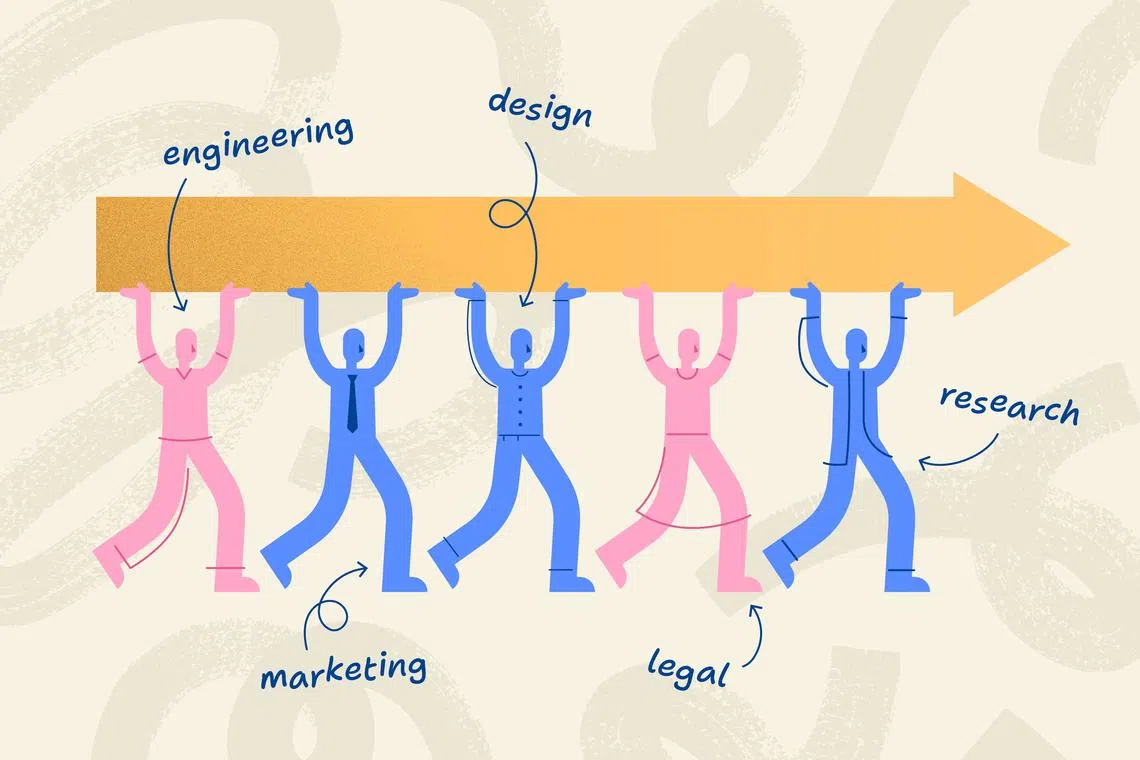askST Jobs: How to pull your weight when all hands are on deck
Sign up now: Get ST's newsletters delivered to your inbox

Involvement in a cross-functional team helps your career.
ST ILLUSTRATION: LEE YU HUI
Follow topic:
In this series, manpower correspondent Tay Hong Yi offers practical answers to candid questions on navigating workplace challenges and getting ahead in your career. Get more tips by signing up to The Straits Times’ Headstart newsletter.
Q: I was asked to join a major work project that cuts across different departments and functions. How can I set myself up for success?
A: Cross-functional projects are becoming increasingly common as organisations tackle complex challenges that cannot be solved within the confines of a single department, says Mr Alvin Aloysius Goh, chief executive of the Singapore Human Resources Institute.
This approach generates more optimal solutions to tackle these complex issues within resource constraints, says Ms Evelyn Chow, founder and adviser of strategic human resources consultancy DecodeHR.
For instance, a product launch may require research and development, engineering, product design, legal, sales, marketing and customer service teams to work together.
Involvement in a cross-functional team helps your career, note both experts.
Ms Chow says this experience hones your ability to communicate with different stakeholders and come up with innovative solutions.
Working on such projects signals your ability to adapt and be collaborative – qualities employers increasingly seek out.
She adds: “For high-potential talent, these projects also act as stretch assignments, helping them build new skills, gain exposure and get noticed by the leadership.”
Mr Goh notes that cross-functional exposure allows workers to see how each function or department depends on others in the organisation to achieve an overarching goal.
“Unlike projects within a single function, where team members typically share the same language, culture and objectives, cross-functional work requires navigating multiple agendas and adapting to unfamiliar workflows or decision-making norms,” he says.
However, not every cross-functional project is smooth sailing.
Ms Chow says: “Cross-functional teams can sometimes have friction when priorities clash, roles aren’t clearly defined or expectations don’t line up, especially since team members are usually balancing these projects alongside their day-to-day work.
“Each function may have its own urgent agenda, and these competing priorities may lead to conflict when negotiating deadlines or deliverables. At times, there may also be duplication of work or missed tasks due to unclear roles.”
To ensure you can contribute meaningfully to the project, Mr Goh suggests you make an effort to understand the overarching objective of the project and why your contributions are needed to make things work.
“Get involved early and help shape the team’s shared understanding of success instead of waiting passively.”
Ms Chow encourages shared goals to be set at the start, and not just individual targets.
The team should work together on any perceived setbacks, instead of pinning the work – and blame – all on one member or department, she adds.
“Team members should also be transparent about their priorities and capacity. This will help to build trust and ensure fair deadlines and manageable workloads.”
Frequent, brief but purposeful communication across teams is a good practice.
“If disputes do occur, it is important to stay calm, keep an open mind and focus on the bigger picture,” Ms Chow says.
“Be mindful of personal biases, rely on facts rather than assumptions, and avoid a ‘me versus them’ mentality.”
Mr Goh encourages workers to be accountable and open to feedback.
“Own your deliverables and timelines. Equally important, invite feedback and be open to it. The best feedback is timely, specific and focused on future improvement.”
Managers and employers need to ensure team members feel comfortable speaking up, and key to achieving that is assigning the right project leaders.
These leaders have to communicate well and bridge people across different domains of expertise.
“Regular check-ins also play a big role in helping cross-functional teams stay on track and work more smoothly,” says Ms Chow.
She adds that teams should openly celebrate joint successes, which will help spur others to join such major, cross-cutting projects in future.
Have a question? Send it to askst@sph.com.sg


